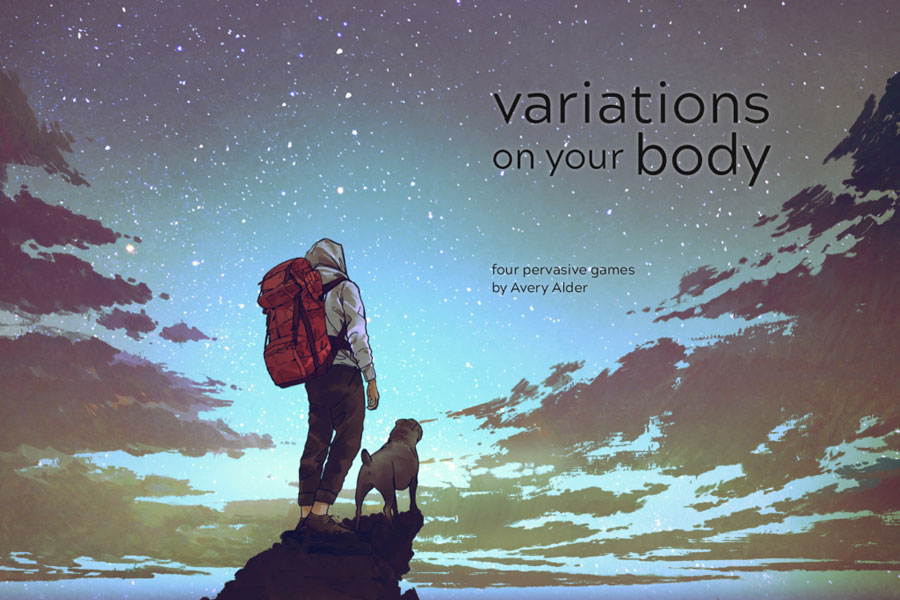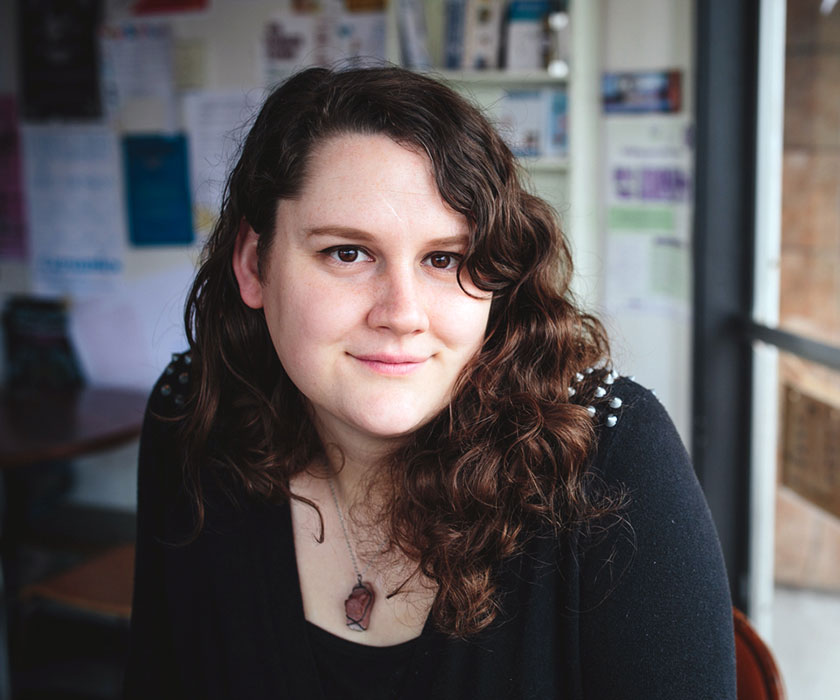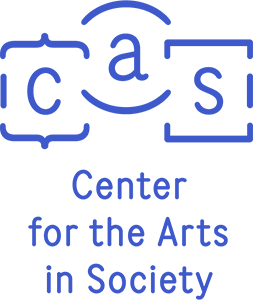
Avery Alder - Good Bones
Solo pervasive game - 2019
The First Rite
You know the ancient magic. We all do. It’s a convenient story that ours is an age abandoned by the gods, the spirits, and the invisible forces. But you know that this convenience is a trap.
You’ve been ensnared by the forces of lethargy, depression, weariness... and yes, convenience. Your home is a tired and sore place. Your body is a tired and sore place. But there is another path forward, and reaching back through lifetimes you remember its way.
Go to your bed. Lie down in total darkness, lights off and blinds shuttered. Open all of your eyes and remember the ancient magic that brought bones to life. If you remember words, whisper them. If you remember gestures, articulate them. Feel the surge of power as it enters you.
Your bones will come to life. You will share this body. A sentience of the mind, housed within your brain, now joined by a sentience of bones, housed within marrow.
Your mind weighs heavy these days, but your bones are strong. They can support you.
Complete this rite before continuing. As you lay in bed, feel your bones waking up, one by one. Whisper to them, from mind to marrow: rise.
Rise.
Asking For Help
Now that there is another consciousness inside you, you’re embarrassed about all the things it will learn. But your bones have been with you all along. They already know.
They already know about every time you struggled to get out of bed, every time you gave up on a task halfway through completing it. The bones know, and they care not. Bone sentience has no judgment, and it offers no guilt. Bone sentience seeks only to support, to remain strong, to offer and receive easement.
The first rite brought your bones to life. The next step forward in this path is more challenging: you must learn to ask them for help.
The sentience of the mind is rich but troubled. Everything hinges upon justification and doubt. The logics produced in your brain find no landing in marrow. You will need to learn to communicate with the bones in ways they can understand. They feel your groaning uncertainties. They want to help. How will you give them an opportunity?
Remember the ancient magic of talking to bones. I cannot teach it to you, for the same reason that I cannot teach you to breathe, or to sleep. You must simply remember. Does it involve humming, a deep rumble that echoes through your body? Does it involve closing your eyes and visualizing the path forward? Begin to experiment.
Whenever you encounter a task that weighs heavy upon you, that feels in some way impossible, talk to your bones and ask them for help.
Each time you ask for help, allow your remembering of the ancient magic to grow deeper, and for your communication with your bones to grow stronger.
Gratitude for Bones
As your communication grows rich, and the bones come to your support time and again, you must begin to ask yourself what gratitude looks like. Are they not your friends, after all?
Listen to your bones speak. What easement do they crave? What work are they longing to do? Are they being forced to sit, uncomfortable and compressed, for hours at a time until they ache?
Bring the bones easement, and show them gratitude. Take care of them, rest them, learn their names and thank them individually. You have woken them up and given them consciousness - while they might be your guardian supporters, they are also your uncanny children.
Stretch them toward the sky, walk them through the deep woods, and lay them comfortably for rest. Give the bones yoga. Lay them down in hot baths. Go to wild places and take off your shoes, so that your bones can feel the ground where you walk.
Bones do not conceive of debt. None of this is scrutinized against a register of obligations. The bones offer their support and strength freely, and it is your choice what you give to them in return. But know that the ancient magic thrives on balance, and gratitude to service is an act of balance.
Forgotten Dreams
You have been doing deep and ancient magic. Your body is now home to two intelligences working in symphony to make more things possible every day. You are built of hundreds of bones, hundreds of muscles, vast networks of tendons, neurons, and so, so much blood. You are a complex and majestic entity. Why are you here in this world?
Without purpose, you are vulnerable. Lethargy works its way into inflamed joints. Weariness gets into your system and goes bone deep. Despair infiltrates your mind and stages a mutiny. But when you woke your bones up, infusing them with sentience, you started to push back against these forces of darkness. You learned to ask for help, and to return it with gratitude. You are getting stronger. But those forces are always looking for a way back in. You must develop a warm light to push them back, blind them, and expunge them.
Go to your bed. Lie down in total darkness, lights off and blinds shuttered. Close all of your eyes and fall into deep slumber. Let forgotten dreams return to you, whether forged of reason or chaos. Sleep for a very long time, and wake up nourished by these powerful visions.
If you cannot yet slumber, if your mind is restless, if your bones are restless, seek relief. Move until tired. Talk until quiet. Work yourself into slumber.
Dream.
As you go about your day, today and every day after, contemplate these once-forgotten dreams. Talk to yourself about them, transferring them between brain and bone, mind and marrow. Do they bring warmth and light into your body? Do they name your purpose? As if compelled by once-forgotten gods, follow them.
Every night, when you lay down to slumber, fall deep into the ancient place of forgotten dreams. Emerge at dawn each morning with new answers. Fill your body with light.
Confluence
As your twin consciousnesses continue to deepen their relationship, of giving and gratitude, of strength and support, a new language will emerge between them. Your mind and your bones will overcome their estrangement, now able to listen to one another and fully comprehend. The asking will become easier, until eventually they are in such harmony that there is no asking needed: the bones are already in motion, the mind is already giving thanks.
There is still a final rite to be honoured. You must welcome the confluence, merging these two sentiences within you, synthesizing a new wholeness for yourself. You will emerge from this final rite a rare being indeed - a hybrid creature of thought and action, of need and capacity, of vulnerability and strength.
Complete this rite in open air - under the light of the sun or the shine of the moon. Be witnessed by trees, rivers, foxes, whatever forces of nature you love most.
For the rest of your life, know and reflect on this wholeness. Feel the wakefulness of your bones, and begin to find it in your blood and musculature. Find the sentience in your breath, in and out of the world, in and out of your body. Grow to fill every inch of yourself.
There will be dark times, when your consciousness will try to crawl fearfully back up into your skull, where it can wall itself off from belonging to your body. It may even succeed. The ancient magic doesn’t provide any answers here; you must decipher your own path forward. Maybe you start over, bringing your bones back to life and again learning to communicate with them. Maybe you isolate and suspend that fear in a magic containment field, before coaxing yourself back into your body. Maybe all you need is a little rest. Now that you have felt a sentience that radiates throughout the body, you know what you are striving to return to.
Bring your whole body to life.
Do spectacular things with it.
Good Bones, Wellness, and the Myth of the Tortured Artist
 Artist’s statement by Avery Alder - April 2020
Artist’s statement by Avery Alder - April 2020
For fourteen years I have designed and written roleplaying games. There are ways in which the practice has enlivened me; transformed me; allowed me to explore and eventually come to inhabit new truths about who I could be in the world. I am grateful to have the sustained opportunity to develop a craft.
But I also feel the ways that writing has been a struggle for me, and that I have carried it heavy in my body.
As I was figuring out what I might want to say today, some words from Virginia Woolf came to mind: “a woman must have money and a room of her own if she is to write fiction.” I thought about my fourteen years writing, and how rare it has been to possess a room of my own and all the time I should like to work in it. I have often written hunched over a laptop, the laptop nesting amid dirty dishes on a too-small kitchen table. I have tried to write books in nap time intervals. When I think about what writing has meant for my body, what the doing of it has looked and felt like, putting aside whatever brilliant immaterial things may have come of it, I mostly feel pain. I notice how my shoulders are curled inward, and at this point it's difficult to open them back up. I notice the back-of-the-head tension headache that I've probably been carrying for hours. My writing has often happened without access to a private, welcoming, ergonomic workspace – and as a result, the work has always required a certain amount of disembodiment to get through. I didn't worry much about this initially.
For much of my life, I was infatuated with the myth of the tortured artist, the writer whose agony brings him—and it was usually a him—brilliant insights into the world. I devoured stories, music, and cultural wisdom built upon this myth.
And so when it became clear that I was living with chronic depression, I did nothing to alleviate it. I let it move into my bedroom, where it lived for years alongside the soreness of my body. I didn't set healthy daily routines. I didn't stretch before sitting down to work. I didn't try to offset the social isolation that often comes with being an independent creator. I gave myself over to feeling crummy, on the false pretense that doing so would make my art better.
It didn't, obviously. Letting yourself feel bad is a bad idea. I figured that out eventually, but after years of collapsing in on myself, it was hard to develop the skills to do otherwise. It's hard to train yourself to be disciplined, structured, self-loving, and prudent.
One of the biggest barriers to doing that personal work was the myth of the tortured artist. I’d spent my adolescence taking in cynical poetry, movies, and songs that romanticized depression. I still held this pernicious belief that it was cool. Edgy. Special. And in contrast, recovery seemed unbearably square. I was still romantically attached to the idea of being sad forever.
I needed a new myth. One that made recovery and self-care seem not only achievable, but cool. What if recovery was incredibly badass, super esoteric, and fully engaged with the darkness? What if recovery was more shadowy and strange than depression could ever claim to be? Maybe I would want it more.
Good Bones is a roleplaying game for one – a piece of immersive theatre you are asked to layer on top of your regular life. In it, you practice necromancy, bringing your bones back to life. Once they are alive, you must do the difficult work of asking them for help, and finding out what you can offer them in exchange for that help.
I wrote this game because I wanted to start cooperating with my body again. I needed both the guidance and the intrigue to do so. Now, I'm sharing it with you. I hope you play it if you need to.
- Download a PDF of Alder’s solo pervasive game collection Variations on Your Body. Available through July 31, 2020.
- Purchase a print version of Variations on Your Body from Alder's website.
Artist’s Bio
Avery Alder [she/her]
Avery is a queer roleplaying game designer hailing from Sinixt territory. She's the designer of Monsterhearts, The Quiet Year, Dream Askew, Ribbon Drive, and a host of smaller, scrappier projects. Avery's work blends facilitation, design, and play – bringing keen curiosity and visionary imagination to how we create together. In her design and play, she gravitates toward the moody, the personal, and the transformative.
